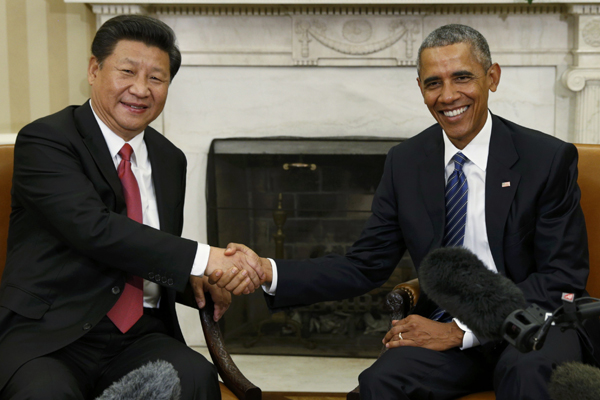Xi's visit invigorates China-US relationship
- By Su Xiaohui
 0 Comment(s)
0 Comment(s) Print
Print E-mail China.org.cn, September 30, 2015
E-mail China.org.cn, September 30, 2015
|
|
|
US President Barack Obama (R) welcomes Chinese President Xi Jinping in the Oval Office of the White House in Washington September 25, 2015. [Photo/China Daily] |
Chinese President Xi Jinping's state visit to the United States was not in the best of times in China-U.S. relationship. In past few months, suspicion of China's peaceful development was hyped in the U.S., and undermined U.S. confidence in building the new type of relationship between major powers with China. Fortunately, Xi's visit has provided a chance for the U.S. to get back on the right track.
The state visit set the tone of the bilateral relationship. It was not the first time that China led the agenda setting. A couple of years ago, when the leaders from both countries held informal meetings at the Sunnylands estate in California, China proposed the idea of building a new type of relationship with the U.S. based on the principles of non-confrontation, non-conflict, mutual respect, cooperation and win-win. The idea was accepted by the U.S. side, but many there have not shaken off their skepticism. Recently, an increasing number of voices in the U.S. have been supporting hard-line policies towards China.
In this context, Xi made it clear to the U.S. leadership that the new type of relationship would always be an effective way to prevent the two countries from clashing. Confrontation and conflict would lead to a lose-lose situation. President Obama received this message from China. Both sides re-affirmed that they should work on the new type of relationship to escape the "Thucydides trap".
The summit this time has also enriched the cooperation between China and the United States. The new type of relationship sets up the "bones" for bilateral ties, and cooperation plays the role of "flesh and blood".
A new field has been explored for cooperation. Enterprises from China and the U.S. signed a framework agreement to build a high-speed rail line in the U.S. It was the first time that China's export of related technology tapped markets in the U.S. At the same time, both China and the United States attached importance to lifting restrictions on exports and lowering barriers to investment. This move definitely will boost trade and investment from both sides and provide an opportunity for a range of enterprises, including those in the fields of clean energy, finance and manufacturing to exploit markets.






